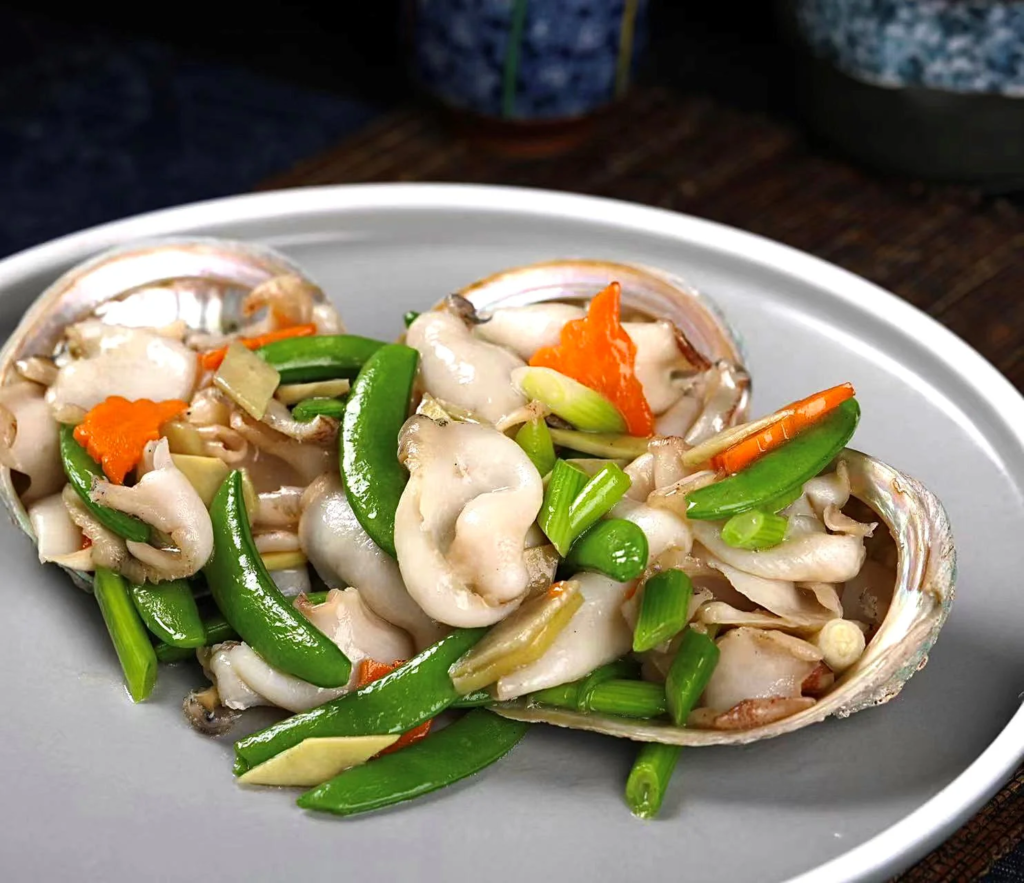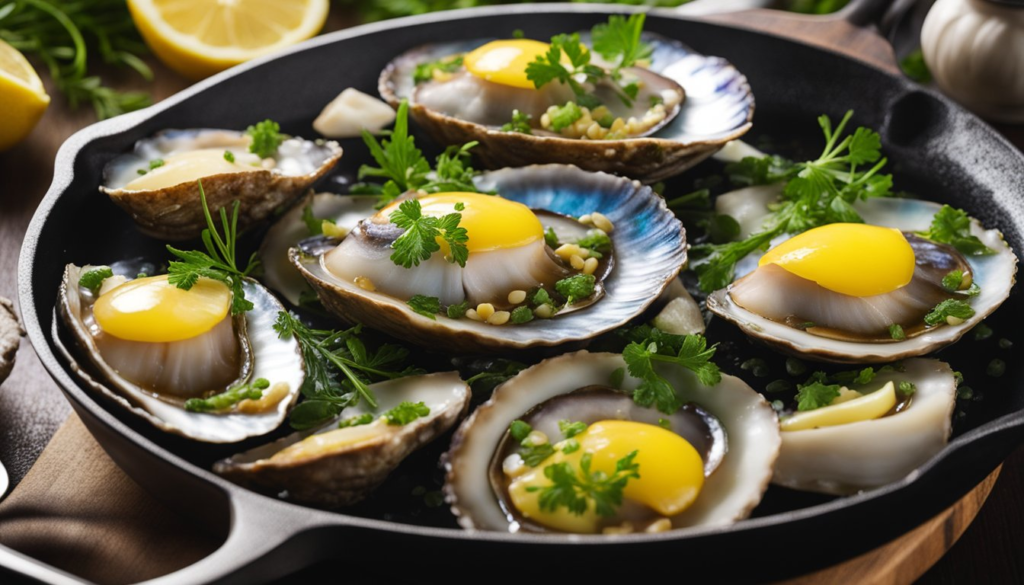How to Cook Abalone: A Simple Guide for Perfectly Tender Shellfish
How to Cook Abalone. Abalone is a prized delicacy known for its rich flavor and tender texture. Cooking abalone can seem intimidating due to its premium nature, but with the right technique, you can prepare a dish that highlights its unique qualities. Whether you’re cooking it for the first time or looking for a new recipe, this guide will walk you through the process of cooking abalone, ensuring it remains tender and delicious.

What is Abalone?
Abalone is a type of marine mollusk that’s highly valued for its edible flesh, which has a sweet and delicate flavor. Often considered a luxury ingredient in many cuisines, particularly in Asian cooking, abalone is enjoyed both raw and cooked. When properly prepared, it can melt in your mouth with a texture similar to a tender scallop.
Ingredients
Here are the basic ingredients you’ll need for a simple abalone dish:
- 2-4 fresh or frozen abalone
- 2 tbsp butter or olive oil
- 2 garlic cloves (minced)
- 1 tbsp soy sauce or lemon juice (optional for flavor)
- Salt and pepper (to taste)
- Fresh herbs (parsley or thyme, optional)
Learn More Recipe: How To Cook Creamy Spinach
Step-by-Step Guide on How to Cook Abalone
1. Prepare the Abalone
If you’re using fresh abalone, start by cleaning them. Use a spoon or small knife to carefully remove the abalone from its shell. Be gentle to avoid damaging the meat. After removal, trim away the dark edges and the tough part of the foot. Rinse the abalone under cold water to remove any sand or debris.
If you’re using frozen abalone, allow it to thaw completely before cooking. Thawing in the refrigerator overnight is recommended.
2. Tenderize the Abalone
Abalone is known for its tough texture if not properly tenderized. You can tenderize it by gently pounding the abalone with a meat mallet or the back of a knife. Be careful not to overdo it, as you want to soften the meat without breaking it apart.
3. Heat the Pan
Place a large skillet over medium heat and add butter or olive oil. Once the butter melts and starts to bubble, or the oil is hot, add the minced garlic to the pan. Sauté for about 30 seconds until fragrant, but be careful not to let the garlic burn.
4. Sear the Abalone
Place the abalone in the pan and cook for 1-2 minutes on each side. The key is to cook the abalone quickly at high heat to avoid overcooking, which can make it tough. The abalone should turn a golden-brown color on the outside while remaining tender on the inside.
5. Add Flavor (Optional)
If you want to enhance the flavor of the abalone, you can add a splash of soy sauce or lemon juice during the last 30 seconds of cooking. This will add a slight tanginess or umami boost to the dish. Alternatively, sprinkle fresh herbs like parsley or thyme for an aromatic touch.
Learn More Recipe: How to Cook Bulalo
6. Serve

Once cooked, remove the abalone from the pan and allow it to rest for a minute. You can serve it as is, or slice it into thin pieces for easier eating. Abalone is often served with a side of fresh salad, steamed vegetables, or rice.
Tips for Cooking Perfect Abalone
- Don’t Overcook: Abalone cooks very quickly, and overcooking can make it rubbery. Keep a close eye on the cooking time and remove the abalone from the heat as soon as it’s golden brown.
- Tenderizing is Key: To achieve the best texture, tenderizing the abalone before cooking is essential. Use a gentle but firm approach when pounding it.
- Simple Seasoning Works Best: Abalone has a naturally sweet and rich flavor, so it’s best to keep the seasoning simple. Garlic, butter, and a dash of salt are usually all you need to highlight the taste.
- Use Fresh or Quality Frozen Abalone: The quality of your abalone will impact the final dish. Fresh abalone is always preferable, but frozen abalone can also be delicious if thawed and prepared correctly.
Health Benefits of Abalone
Abalone is not only a delicacy, but it’s also packed with nutritional benefits. It is a great source of high-quality protein, which helps in muscle repair and growth. It is also rich in essential vitamins and minerals, including vitamin E, selenium, magnesium, and iron. Abalone is low in fat and high in omega-3 fatty acids, which are beneficial for heart health. Additionally, it contains antioxidants that support immune function and reduce inflammation.
Serving Suggestions
Abalone pairs well with a variety of side dishes. Here are some ideas to complement your abalone:
- Steamed or grilled vegetables (such as asparagus or broccoli)
- A fresh green salad with a light vinaigrette
- Lemon garlic butter sauce for extra flavor
- Steamed jasmine rice or wild rice
- Crusty bread to soak up any leftover sauce
Learn More Recipe: How To Cook A Honey Baked Ham
Conclusion
Cooking abalone at home can seem like a challenge, but with this step-by-step guide, you’ll be able to prepare a perfectly tender and flavorful dish every time. Remember to focus on tenderizing the meat and not overcooking it. Whether you’re cooking for a special occasion or just treating yourself to a luxurious meal, abalone is sure to impress with its unique flavor and texture.
Frequently Asked Questions (FAQ)
1. How long should I cook abalone?
Abalone cooks very quickly, typically 1-2 minutes per side. Overcooking can make it tough and rubbery, so keep an eye on the clock to ensure it stays tender.
2. Do I need to tenderize abalone?
Yes, tenderizing abalone is crucial for a soft and tender texture. Gently pound the abalone with a meat mallet or the back of a knife to soften the meat before cooking.
3. Can I freeze abalone?
Yes, abalone can be frozen. To freeze, wrap the cleaned abalone tightly in plastic wrap or a freezer-safe bag. It can be frozen for up to 3 months. Thaw it slowly in the refrigerator before cooking.
4. What does abalone taste like?
Abalone has a mild, slightly sweet flavor, with a texture similar to a tender scallop. It’s often described as having a delicate, oceanic taste with a rich, buttery finish.
5. How do I know when abalone is cooked?
You’ll know abalone is cooked when it turns golden brown on the outside, but remains tender. A properly cooked abalone should feel slightly springy to the touch, similar to a medium-rare steak.
Learn More Recipe: How To Cook An Egg In Ramen